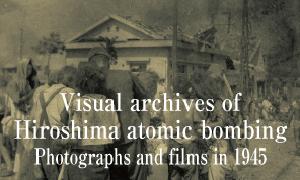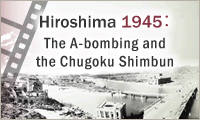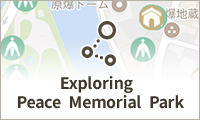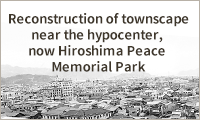Documenting Hiroshima of 1946: In May, A-bomb widow receives letter of condolence
May 29, 2025
by Maho Yamamoto, Staff Writer
In May 1946, a letter reached Yukiko Toma, a widow who had lost her journalist husband in the atomic bombing of Hiroshima and who ultimately died in 2008 at the age of 92. In the letter was written the sentiment, “Please accept my deepest sympathies for your hardship with the loss of the head of your household.” Ms. Toma had been struggling to raise five daughters in her hometown of Tsuyama City.
This letter, dated May 20, was sent by Yoshio Tage. Mr. Tage is thought to have been a colleague of her late husband, Kanji Toma, who worked as a reporter for the Godo Shimbun (present-day Sanyo Shimbun), based in Okayama City.
Ms. Toma had previously consulted with Mr. Tage regarding financial support for her family but was told that the company would have difficulty helping, given that other employees had also died while at work. Instead, informing her that, “We have formed a support group and started to raise funds,” the letter added the words of encouragement, “I hope you will take heart and do your best for a bit longer.”
In May 1945, Kanji, 33 at the time, had moved to Hiroshima City without his wife, who was about to give birth, or his daughters. On August 6, he seems to have experienced the atomic bombing near his company’s Hiroshima branch office, which was located in the area of Shimonagarekawa-cho (in Hiroshima’s present-day Naka Ward), and had been carried to Funakoshi National School (present-day Funakoshi Elementary School, in the city’s Aki Ward).
A message he had entrusted with the woman taking care of him at the time reached Ms. Toma in Tsuyama City by express mail on August 16, 1945. Relatives took him back to Tsuyama City, but he died on August 24. Two days before the atomic bombing, he had sent a postcard addressed to his family in which was included the information, “I will return home around August 12 or 13th.”
After the war, Ms. Toma worked at a cotton-thread factory while carrying on her back her fifth daughter, who had been born in June 1945. In an interview with a representative from the Sanyo Shimbun’s labor union conducted in 1985, she spoke about that time. “I had no other way to survive than working very hard. I did everything I could, including work as a street vendor, in a public works project for the unemployed, and as a dormitory caretaker,” she said.
Ms. Toma’s third daughter Teruyo, 83, a resident of Takarazuka City in Hyogo Prefecture, also remembers her mother working hard to raise her children. Teruyo described how her mother had displayed a portrait she herself had drawn of their father, Kanji, in one room at home, often telling them that their father was looking over them. She said, “I would give my greetings, saying ‘I’m leaving now,’ and inform him of my grades at school.” Although the family’s life was hard, Kanji was always there at the center of things.
(Originally published on May 29, 2025)
In May 1946, a letter reached Yukiko Toma, a widow who had lost her journalist husband in the atomic bombing of Hiroshima and who ultimately died in 2008 at the age of 92. In the letter was written the sentiment, “Please accept my deepest sympathies for your hardship with the loss of the head of your household.” Ms. Toma had been struggling to raise five daughters in her hometown of Tsuyama City.
This letter, dated May 20, was sent by Yoshio Tage. Mr. Tage is thought to have been a colleague of her late husband, Kanji Toma, who worked as a reporter for the Godo Shimbun (present-day Sanyo Shimbun), based in Okayama City.
Ms. Toma had previously consulted with Mr. Tage regarding financial support for her family but was told that the company would have difficulty helping, given that other employees had also died while at work. Instead, informing her that, “We have formed a support group and started to raise funds,” the letter added the words of encouragement, “I hope you will take heart and do your best for a bit longer.”
In May 1945, Kanji, 33 at the time, had moved to Hiroshima City without his wife, who was about to give birth, or his daughters. On August 6, he seems to have experienced the atomic bombing near his company’s Hiroshima branch office, which was located in the area of Shimonagarekawa-cho (in Hiroshima’s present-day Naka Ward), and had been carried to Funakoshi National School (present-day Funakoshi Elementary School, in the city’s Aki Ward).
A message he had entrusted with the woman taking care of him at the time reached Ms. Toma in Tsuyama City by express mail on August 16, 1945. Relatives took him back to Tsuyama City, but he died on August 24. Two days before the atomic bombing, he had sent a postcard addressed to his family in which was included the information, “I will return home around August 12 or 13th.”
After the war, Ms. Toma worked at a cotton-thread factory while carrying on her back her fifth daughter, who had been born in June 1945. In an interview with a representative from the Sanyo Shimbun’s labor union conducted in 1985, she spoke about that time. “I had no other way to survive than working very hard. I did everything I could, including work as a street vendor, in a public works project for the unemployed, and as a dormitory caretaker,” she said.
Ms. Toma’s third daughter Teruyo, 83, a resident of Takarazuka City in Hyogo Prefecture, also remembers her mother working hard to raise her children. Teruyo described how her mother had displayed a portrait she herself had drawn of their father, Kanji, in one room at home, often telling them that their father was looking over them. She said, “I would give my greetings, saying ‘I’m leaving now,’ and inform him of my grades at school.” Although the family’s life was hard, Kanji was always there at the center of things.
(Originally published on May 29, 2025)









